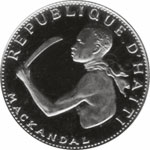François Mackandal facts for kids
Quick facts for kids
François Mackandal
|
|
|---|---|

Mackandal on a 20 gourde coin, 1968
|
|
| Born | |
| Died | 1758 |
| Occupation | Maroon |
François Mackandal (died 1758) was an important Maroon leader in Haiti. Maroons were groups of enslaved people who had escaped and formed their own communities. Mackandal was an African spiritual leader, sometimes called a Haitian vodou priest or houngan. Some people think he might have been Muslim, possibly from Senegal, Mali, or Guinea. However, we don't have much information from that time, so this is not certain.
A Haitian historian named Thomas Madiou said that Mackandal was educated and knew Arabic well. But because Haitian Vodou was very common on the island, most people believe Mackandal was connected to that faith. In a book called "Open door to Liberty," Mackandal is mentioned as a Vodou priest who joined Maroons to fight against the French in Saint-Domingue (which is now Haiti). He was later caught and executed by the French. Even though some details about his life are debated, Mackandal is remembered as a key leader in the fight for Haitian freedom. His image is even on Haitian money.
Mackandal was known for using natural plants to create substances. He used these to organize a large plan to resist the French slave owners. This movement caused a lot of fear among the owners.
Biography
We don't know much about Mackandal's early life. Even the year he was born is a mystery.
Mackandal learned how to make special substances from plants found on the island. He shared these with enslaved people. He became a strong and inspiring leader who brought different Maroon groups together. He also created a secret network that connected with enslaved people who were still working on plantations.
Mackandal led Maroons to attack plantations at night. They would burn property and fight against the owners.
In 1758, the French were worried that Mackandal would drive all white people out of the colony. They captured one of Mackandal's allies, who then shared information that led to Mackandal's capture. After six years of planning and building his resistance network, he was captured. He was executed in the main square of Port-au-Prince in front of many people.
However, many people in the crowd, especially the enslaved Africans, believed something amazing happened. They thought Mackandal rose out of the flames and turned into a winged creature that flew away to safety. This story is a famous part of Haitian folklore.
Beyond the historical facts, many colorful stories and myths exist about Mackandal's life. These supernatural tales about his escape and execution are still told in island folklore. They are also shown in paintings and popular art.
It is thought that Mackandal might have lost his right arm in a farming accident. His arm might have gotten caught and crushed in a machine used for processing sugarcane.
See also
 In Spanish: François Mackandal para niños
In Spanish: François Mackandal para niños

